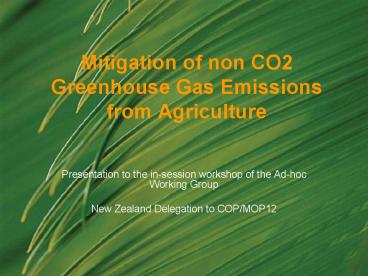Mitigation of non CO2 Greenhouse Gas Emissions from Agriculture
Title:
Mitigation of non CO2 Greenhouse Gas Emissions from Agriculture
Description:
Presentation to the in-session workshop of the Ad-hoc Working Group ... Direct modification of microbial processes: Protozoa, Acetogens, Phage, Methanogens ... –
Number of Views:223
Avg rating:3.0/5.0
Title: Mitigation of non CO2 Greenhouse Gas Emissions from Agriculture
1
Mitigation of non CO2 Greenhouse Gas Emissions
from Agriculture
- Presentation to the in-session workshop of the
Ad-hoc Working Group - New Zealand Delegation to COP/MOP12
2
Agriculture greenhouse gas emissions
- Represents 14 of global GHG emissions
- Represents 7.4 of Annex 1 emissions
- Represents 26 of non-Annex 1 emissions
- Mitigation options are relatively limited
3
Agriculture is important
- Agriculture supplies food to the world
population expected to increase from 6 billion to
9 billion by 2050 - Agriculture is important for the sustainable
development of communities and national
economies, for both developed and developing
countries
4
New Zealand emissions
5
NZ agriculture situation
- A reliance on the export of primary products
- Dynamic land use meeting market demand
- 49 of total GHG emissions from agriculture
(highest of any developed country) - Highly efficient production
6
NZs agriculture emissions profile
7
The challenge
- Biological systems are complex
- 64 of New Zealands agricultural emissions have
no current feasible mitigation solution - At present, practical mitigation options for
grazing ruminants and grazed pastures are limited - More research is required globally, however, this
is of a lower priority in most developed
countries
8
Current focus in agriculture
- PGGRC a government/sector partnership for
agriculture research - Measurement crucial
- Technology adoption becoming more of a focus
9
Mitigation of ruminant methane emissions
- Animal variability
- Genetics (variation between animals 14-26
g-CH4/kg dm intake) - Nutrition
- Production system
- Microbial
- Direct modification of microbial processes
Protozoa, Acetogens, Phage, Methanogens - Vaccination
- Monensin (up to 10) - in grain diets forage
diets 0 - Medium chain fats
- Plants
- Plant extracts
- Plant species (tannins up to 10)
- High sugar grasses
10
Mitigation of nitrous oxide emissions
- Reduce the amount of excreta N
- Replace N boosted grass with maize silage
- High sugar grasses
- Shift N balance from urine to dung
- Increase N efficiency of excreta and N fertiliser
- Restricted grazing of dairy and beef animals
- Effluent utilisation on dairy farms
- Nitrogen fertiliser timing, rates and forms
- Nitrification inhibitors DCD has real promise
and is commercially available in NZ - Avoid anaerobic soil conditions
- Improve drainage
- Avoid compaction
11
Conclusions
- There is no simple single solution for CH4 and
N2O from agriculture - a package of measures will
be required - Reducing methane emissions from grazing ruminants
currently has limited options available - Options need to be evaluated at the farm scale
and for all three major GHGs collectively GHG
footprint of total system - GHG measurement will continue to be an issue
- Increased international effort particularly in
ruminant methane mitigation in pastoral
agriculture is needed
12
(No Transcript)































